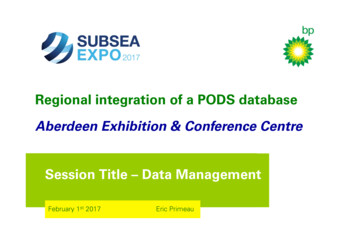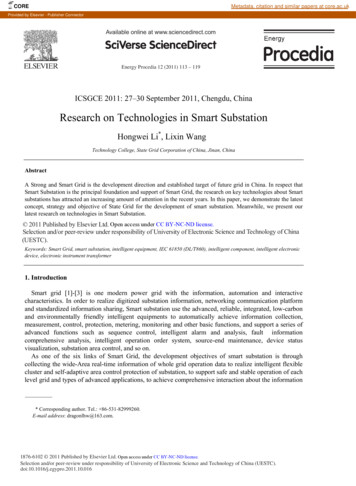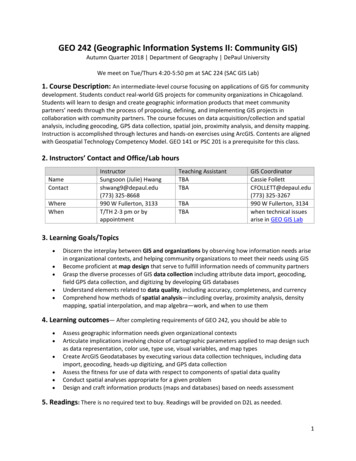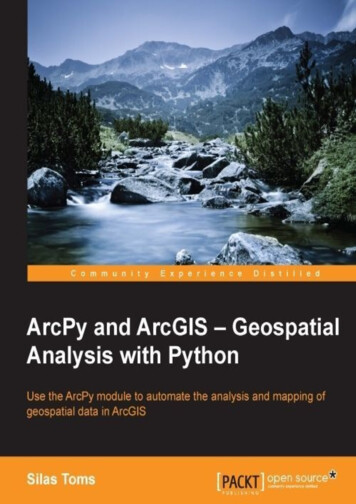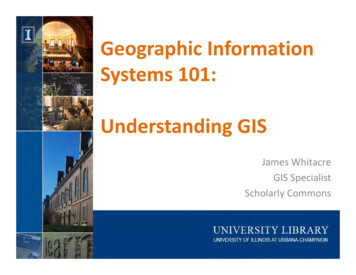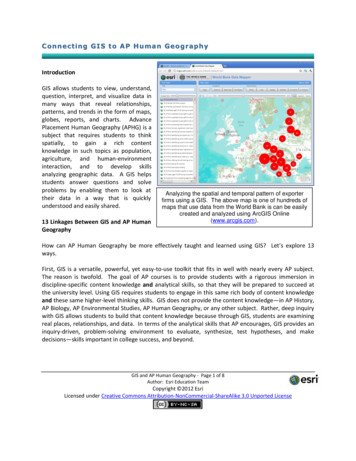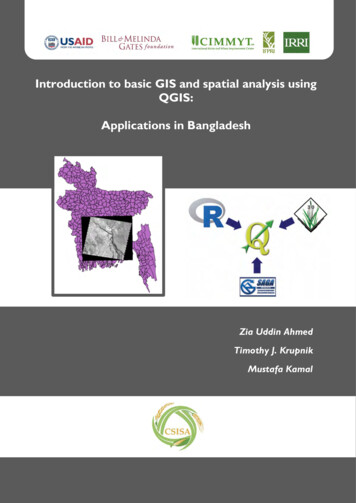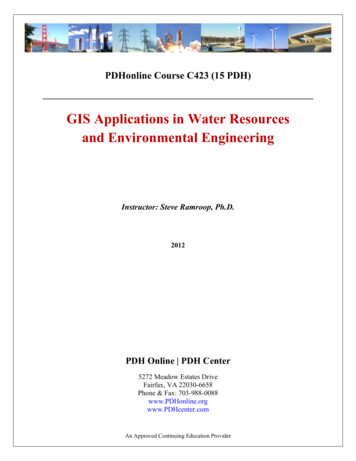
Transcription
PDHonline Course C423 (15 PDH)GIS Applications in Water Resourcesand Environmental EngineeringInstructor: Steve Ramroop, Ph.D.2012PDH Online PDH Center5272 Meadow Estates DriveFairfax, VA 22030-6658Phone & Fax: 703-988-0088www.PDHonline.orgwww.PDHcenter.comAn Approved Continuing Education Provider
www.PDHcenter.comPDH Course C423 – Lecture 5www.PDHonline.orgCOURSE CONTENT – Lecture 5Course C423 is a practical GIS course with particular reference to applications inWater Resources and Environmental Engineering, addressing some of the basic,yet common GIS needs in these two fields. The course describes the availability offree databases and public domain GIS software, and their use in performingcommon GIS processing tasks that are relevant to Water Resources andEnvironmental Engineering. The ability to search, download and make use of suchdata sets and software is presented within the context of this course. The courseconsists of 5 lectures, which start off with introductory level material in Lecture 1,and progressively builds up through the remaining four lectures. A basic awarenessof the concept of GIS is desirable but not required as a pre-requisite for this course.The following topics are covered in this 5th lecture of Course C423: Case Studies: GIS Water Resources applications GIS Environmental Engineering applications 2010 Steve Ramroop, Ph.D.Page 2 of 48
www.PDHcenter.com1.PDH Course C423 – Lecture 5www.PDHonline.orgGIS Case StudiesThe remaining sections of this fifth (and final) lecture in the series will focus onthose previous lectures that relate to environmental engineering and waterresources applications.GIS is a powerful tool for developing solutions for water resources, such asassessing water quality and managing water resources on a local or regional scale.Hydrologists use GIS technology to integrate various data and applications intoone, manageable system.There are various categories of GIS for waterresources. For this reason it was decided to use the ESRI website which is wellknown in the GIS industry, to present a few of the case studies. The classificationof water resources applications are as follows: Water Resources ManagementWatershed ManagementFlood ManagementGroundwaterWater QualityBiodiversity and HabitatPollution Prevention and ControlRegulatory ComplianceSustainable DevelopmentAgencies and OrganizationsIn Environmental Engineering applications, the managers use GIS to make landuse planning decisions, monitor environmental remediation sites, and comply withenvironmental regulations. With GIS, they can: Incorporate existing foundation data—such as current land use, distance to utilities and environmental concerns, and other information—into thedecision-making process.Include existing installation rules and regulations in the analysis.Develop, capture, and share a site selection process model for reuse andrefinement.Generate automated reports and share the results.Provide carbon footprint accounting. 2010 Steve Ramroop, Ph.D.Page 3 of 48
www.PDHcenter.comPDH Course C423 – Lecture 5www.PDHonline.org1.1 Water Resources GIS ApplicationsCase Study 1:Mapping and Managing Potable Water Infrastructure Assets in Cocoa,Florida 1The use of GPS/GIS data collection improved efficiency in the project’s datacollection procedure. The City of Cocoa, located on the east coast of Florida, isone of the largest suppliers of potable water in the state. Not only does the citysupply drinking water to its incorporated residents, it also supplies potable waterto neighboring communities, including Cocoa Beach, Merritt Island, Rockledge,Titusville, Cape Canaveral, Patrick Air Force Base, and unincorporated BrevardCounty. That translates into nearly 70,000 customers consuming about 27million gallons of potable water per day.Keeping track of such a large utility has presented an ongoing challenge for thecity's Utility Department. The Engineering Division, responsible for design andconstruction, and the Transmission and Distribution (T&D) Division, responsiblefor operation and maintenance, made the decision back in 2002 to beginmapping and managing the potable water utility using GIS.The initial phase of mapping the system was accomplished by entering potablewater assets into a geodatabase via heads-up digitizing using the city's recorddrawings as the source. While this was a step in the right direction, the city soonrealized that the true physical location of critical assets, such as valves andhydrants, was not represented accurately in the record drawings. Knowingexactly where aboveground potable water assets are is extremely important,especially to T&D staff. Locating valves is essential during a water main break tobe able to quickly cut off the flow of water to reduce flooding, water damage, andunnecessary waste. With Cocoa and its neighbors being coastal communities,this is even more challenging, as hurricanes and tropical storms are common. Inlight of this situation, T&D decided to purchase two Trimble GeoXT GPS unitsand have their staff begin collecting map grade locations of the system'saboveground assets.The project involved the use of the latest GPS and GIS technology in acooperative effort with T&D staff to produce a highly efficient and accurateproduct. They would collect GPS points; edit the GIS features in real time in thefield; and incorporate assistance from T&D staff for utility locations, system data,and connectivity.Using a ruggedized laptop computer equipped with ArcGIS ArcInfo and TrimbleGPS Analyst software, a link was established from the Trimble GeoXT to icles/mapping-and-managing.html 2010 Steve Ramroop, Ph.D.Page 4 of 48
www.PDHcenter.comPDH Course C423 – Lecture 5www.PDHonline.orglaptop via a Bluetooth connection. The GeoXT was also connected to aGeoBeacon for real-time GPS correction. After the features were located anddesignated by T&D staff, GPS points were collected on the GeoXT anduploaded live to a GPS-enabled geodatabase on the laptop using GPS Analystfield tools. GIS features, entered previously from the city's record drawings, andwere rectified immediately in the field to the GPS points using ArcInfo editingtools. T&D staff provided their knowledge to assist in system connectivity anddata attribute input. A geometric network was incorporated to facilitate theefficient spatial adjustment of GIS features. 2010 Steve Ramroop, Ph.D.Page 5 of 48
www.PDHcenter.comPDH Course C423 – Lecture 5www.PDHonline.orgCase Study 2:Tampa Bay Water Deploys GIS to Model Potable Water Distribution2The highlights of this project are as follows: With ArcGIS Server, GIS staff rendered hundreds of gigabytes oftime-series vector and raster data in advance. Viewing temporal water consumption at an individual parcel levelallows high-resolution thematic mapping. Modeling enables the board of directors to make infrastructure andcapital decisions.Tampa Bay Water, a regional water authority whose jurisdiction includes threeheavily populated counties in Florida (Hillsborough, Pasco, and Pinellas), isresponsible for providing potable water to the Tampa Bay area's regionalmember government utilities. These local governments include HillsboroughCounty, City of New Port Richey, Pasco County, Pinellas County, City of St.Petersburg, and City of Tampa. Tampa Bay Water's mission is to developreliable and cost-effective water supply sources to meet the growing demandsof the region with minimal impact to the environment. Tampa Bay Water staffmanages a vast infrastructure of pipelines, water treatment plants, reservoirs,and the largest seawater desalination plant in North America. This infrastructureserves an area with a current population of approximately 2.5 million peoplegrowing at close to 3 percent per rticles/tampa-bay-water.html 2010 Steve Ramroop, Ph.D.Page 6 of 48
www.PDHcenter.comPDH Course C423 – Lecture 5www.PDHonline.orgTampa Bay Water relies onGIS for various aspects ofitsoperations.Mostnotably, GIS is used tomanage the regional watersupply source rotation,whichhelpsminimizeimpacts to its groundwaterand surface water supplies,as well as the surroundingwetlandandaquifersystems of the region.GOVNET provides users with thematicmapping capabilities for monthlyIn June 2007, Tampa Bayparcel-level water use. This is aWater was tasked by itsneighborhood-levelthematicmapmember governments toshowing potable water distribution fordevelop a high- resolutionFebruary 2008. The dark green parcelswaterdistributionare the lowest water users (0-500(consumption) applicationgallons per month), and the dark redto analyze where and howparcels are the highest water usersthe potable water was(more than 1 million gallons perbeing used in the region.month).This application, namedGOVNET, would becomethe basis for managing all future water conservation efforts.GOVNET's functionality includes the ability to view, analyze, and query timeseries water consumption data at various resolutions (regional, city,neighborhood, street, parcel) and retrieve charts, graphs, and reports for waterdemand.GOVNET's use of temporal and spatial data heavily increases the memory andstorage demands of the ArcGIS Server infrastructure. To model waterdistribution and consumption at the parcel level over time, Tampa Bay Waterneeded a reliable platform that would ensure adequate speed for data retrievaland map requests through the Web browser. With the help of ArcGIS Servertechnology's data caching abilities, Tampa Bay Water's GIS staff was able torender hundreds of gigabytes of time-series vector and raster data in advancefor fast retrieval through the Web browser. This data is housed in Tampa BayWater's enterprise GIS system, which includes a multiterabyte ArcSDEgeodatabase server and various nonspatial SQL servers used to collect variouswater quality, consumption, SCADA, and wetland data. 2010 Steve Ramroop, Ph.D.Page 7 of 48
www.PDHcenter.comPDH Course C423 – Lecture 5www.PDHonline.orgThe ArcGIS Server Web Application Developer Framework (ADF) providesusers who have minimal GIS experience and training with a reliable template forGIS applications that Tampa Bay Water will use as the framework for all futureapplication enhancements. Tampa Bay Water makes use of high-performancescalable servers to accommodate future growth of the GOVNET application, aswell as simultaneous users and queries.GOVNET also incorporates Microsoft's Virtual Earth to provide street-levelphotography and one-half-foot digital orthophotography from various third-partysources. Reporting tools allow a user to use statistics to view average, median,maximum, and minimum water consumption at user-defined intervals.The successful implementation of GOVNET became possible because TampaBay Water had diligently collected time-series billing data from its membergovernments on a monthly basis from 1998 to the present at an account level.This data represents over a half million water use accounts across the region,all of which were subsequently geocoded to a physical parcel. The ability toview temporal water consumption at an individual parcel level gives Tampa BayWater high-resolution thematic mapping abilities, which provided the basefunctionality for the GOVNET application. This account data is very importantfor regional demand planning and budgeting and is also used by Tampa BayWater to model long-term demand forecasts for potable water, which allow theTampa Bay Water board of directors to make decisions about futureinfrastructure needs and capital improvement projects.The success of GOVNET is not going unnoticed in the Tampa Bay region. Newrequests for application access from local water demand managers andconservation coordinators continue to pour in. The Florida Yards andNeighborhoods Association recently utilized GOVNET to provide basin analysisfor water users around the Brooker Creek Preserve, an 8,500-acre wildernessarea managed by Pinellas County.Tampa Bay Water is exploring future applications to the GOVNET framework,including incorporating conservation program data to allow demand managersto see how responsive water consumption is to targeted conservation measuresover time. Using this targeted approach to conservation will help ease waterdemand for Tampa Bay Water and help further its goal of a reliable andsustainable water supply for generations to come. 2010 Steve Ramroop, Ph.D.Page 8 of 48
www.PDHcenter.comPDH Course C423 – Lecture 5www.PDHonline.orgCase Study 3:Lake Management GIS3This project: makes use of ArcView to quickly create bathymetric data, perform editing,and create cartographic output. Uses ArcPad's simple API to save time. Helps to accurately apply herbicide to targeted areas.Saratoga Lake is a 4,000-acre lake located in Saratoga County, New York. The highlyinvasive Eurasian watermilfoil weed was reportedly introduced to Saratoga Lake in themid-1970s and reached nuisance densities by the early 1980s. Planning efforts beganin 1982, and in 1986 a mechanical harvesting program was initiated to cut and removethe weed from the lake. The Saratoga Lake Protection and Improvement District(SLPID) was created in 1986 to oversee the harvesting operations. Harvesters wereoperated between mid-May and mid-September each year. While simultaneouswatershed management efforts improved water quality, the Eurasian watermilfoilinfestation became worse. By the mid-1990s, most of the lake perimeter less than 15feet deep supported dense Eurasian watermilfoil that would grow to the surface andgreatly interfere with recreational boating and swimming, not to mention adverseimpacts to fish, wildlife, and water quality. The harvesting program simply could notkeep up with the proliferating ticles/lake-management.html 2010 Steve Ramroop, Ph.D.Page 9 of 48
www.PDHcenter.comPDH Course C423 – Lecture 5This map illustrates thepresurvey bathymetry data thatwas collected in 1980 and thenew depth measurement points.www.PDHonline.orgThis map shows the newpostsurvey 2004 bathymetry dataalong with the occurrence ofEurasian watermilfoil in the lake.SLPID prepared a comprehensive watershed management plan in the late 1990s. Onerecommendation was to conduct demonstration herbicide treatments to evaluate theirefficacy as compared to the ongoing mechanical harvesting program. Aquatic ControlTechnology, Inc., an applied lake management company, was selected through acompetitive procurement process to perform the demonstration herbicide treatment in2000. Aquatic Control Technology was primarily selected for its technical approach,which included the use of real-time differential GPS navigation of the treatment boat.An ArcView and GPS interface created by Colorado-based Esri Business PartnerAnimas Geographic Technology was successfully used for the treatment. 2010 Steve Ramroop, Ph.D.Page 10 of 48
www.PDHcenter.comPDH Course C423 – Lecture 5www.PDHonline.orgFollowing a second demonstrationtreatment in 2003, Aquatic ControlTechnology was contracted to develop along-term aquatic plant managementplan for Saratoga Lake in 2004. AquaticControl Technology realized it needed abetter way to perform pretreatmentsurvey activities and the treatment itself.The company also needed a way toproduce accurate calculations of lakevolumes at various depth thresholds toplan for the best treatment methodology.This was a challenge, because existingbathymetry data dated back to 1980 and SONAR and GPS data flows intono new depth survey work had been an ArcPad point feature shapefileperformed. Bathymetry is the underwater that was then used to developequivalent of topography and a the updated bathymetry data.bathymetric survey is akin to a topographic survey of the floor of a body of water.Aquatic Control Technology also needed a way to accurately navigate multipletreatment crafts in real time.Animas Geographic Technology worked with Aquatic Control Technology to create areal-time data collection application that combined differential GPS input with sonar.Animas Geographic Technology selected ArcPad to provide Aquatic ControlTechnology with a lightweight and flexible data collection/navigation application. Usingthe application, Aquatic Control Technology was able to efficiently collect enough datato create new bathymetry data for the entire lake bed. ArcPad was selected for thesimple and flexible application development interface it provided. ArcPad saved timeand allowed Animas Geographic Technology to focus on data collection workflows andintegrating the sonar and GPS equipment. ArcPad also offered a platform that wouldrun on both Windows XP and Windows CE, which was important to Aquatic ControlTechnology since it had invested in both handheld and laptop field computers. 2010 Steve Ramroop, Ph.D.Page 11 of 48
www.PDHcenter.comPDH Course C423 – Lecture 5Animas Geographic Technology selectedArcView desktop software for dataprocessing and editing and cartographicoutput. Since the field data was collectedusing ArcPad, the resultant GIS data wasreturned to the office in a readilycompatible format that could immediatelybe used within ArcView. The superiorGIS data editing capabilities of ArcViewallowed Animas Geographic Technologyto quickly create the new bathymetrydata that was in turn used to developvolumetric calculations for the areas ofinvasive weed growth, as well asprofessional cartographic products. Thenew bathymetry data was then used tocreate a new three-dimensional spatialdata representation of the lake beddetailing weed-choked areas. AquaticControl Technology also used the realtime differential GPS capability of theapplication to navigate this large openwater body and precisely apply herbicideto targeted areas for control of thepervasive Eurasian watermilfoil growth in2007.www.PDHonline.orgSaratoga Lake has experienced aEurasian watermilfoil infestationthat greatly interferes withrecreational boating andswimming, not to mentionadverse impacts on fish, wildlife,and water quality.The Saratoga Lake Protection and Improvement District was extremely pleased withthe results of the 2007 program and has committed to an even larger-scale project in2008.The application that Animas Geographic Technology created has automated much ofAquatic Control Technology's business process in the field and is routinely used forgeospatially referenced aquatic plant surveys, as well as for real-time navigation onlarge treatment projects. Aquatic Control Technology selected Animas Geographic 2010 Steve Ramroop, Ph.D.Page 12 of 48
www.PDHcenter.comPDH Course C423 – Lecture 5www.PDHonline.orgTechnology based on its experience using GIS and GPS for data collection andanalysis coupled with its custom application development expertise. 2010 Steve Ramroop, Ph.D.Page 13 of 48
www.PDHcenter.comPDH Course C423 – Lecture 5www.PDHonline.org1.2 Watershed ManagementCase Study 1:Creating a Watershed Stormwater Basin Inventory4Data was gathered using Tablet PCs running ArcPad. Levels of total suspendedsolids (TSS) or particulate matter are good indicators of stream health. Highconcentrations of TSS can ruin habitat for fish and other aquatic life by increasingsedimentation and siltation and provide attachment places for pollutants such asmetals and bacteria. This is an inventory project using GIS to gather field data on aPennsylvania watershed that is being used for implementing stormwater managementcontrols to lessen TSS load.An inventory project gathered data on a Pennsylvania watershed using ruggedizedTablet PCs running ArcPad. This data provided better information about storm waterinfrastructure that will help communities in the watershed reduce the overall totalsuspended solids (TSS) load by implementing stormwater management bestpractices.The Wissahickon Creek Watershed Stormwater Basin Inventory was implemented bythe Philadelphia Water Department (PWD) as part of a larger watershed-wide planninginitiative under way in the Wissahickon Creek Watershed (WCW). PWD beganinitiating intergovernmental, multijurisdictional partnerships in 1999 to create andimplement watershed-focused strategies for ecological restoration and water qualityimprovement.These initiatives recognize that watersheds do not stop at municipal borders.Development trends in upstream communities dramatically affect downstreamwaterways and natural resources. PWD initiated a watershed planning process withinWCW in 2005. The Wissahickon Basin Inventory initiative presented an opportunity forimplementing a mutually beneficial data gathering process between upstream anddownstream municipalities.WCW has a total drainage area of approximately 64 square miles. According to theDelaware Valley Regional Planning Commission's (DVRPC) year 2000 land-use data,more than 65 percent of this watershed area has been developed. This developmenthas resulted in land cover that is mostly impervious to water. Furthermore, largeportions of WCW experienced extensive land development prior to the implementationof stormwater management controls required by the Pennsylvania StormwaterManagement Act of 1978. According to the Wissahickon Creek River ConservationPlan (2002), approximately 60 percent of the watershed area was developed prior tothe adoption of runoff control ordinances that limit impervious areas or requiredetention of stormwater ncruz.html 2010 Steve Ramroop, Ph.D.Page 14 of 48
www.PDHcenter.comPDH Course C423 – Lecture 5www.PDHonline.orgThe consequences of this unmanaged land development process have includedsevere stream bank erosion, flooding, and impairment of aquatic communities. Morethan 90 percent of stream segments in WCW are listed by the PennsylvaniaDepartment of Environmental Protection (PA DEP) as impaired due to siltation. In2003, a Total Maximum Daily Load (TMDL) for siltation was established by the U.S.Environmental Protection Agency (EPA), Region III. The TMDL program determinesthe safe level of loading for a pollutant—in this case TSS—and allocates that loadequitably among dischargers through the stormwater permitting process.Municipalities needed to identify sources of TSS loading and find ways to reduce theload. The Wissahickon Basin Inventory has given municipal partners updatedinformation about their stormwater infrastructure as well as a tool that assists inplanning overall TSS load reduction. 2010 Steve Ramroop, Ph.D.Page 15 of 48
www.PDHcenter.comPDH Course C423 – Lecture 5www.PDHonline.orgCase Study 2:Italian Province Tackles Hydrological Hazards with GIS5The highlights of the system are as follows: System supported by ArcGIS Desktop simplifies the planning of newhydraulic structures. Geodatabase stores land-use, geology, morphology, hydrologic network,hydraulic structure, and hydrologic hazard data. Flood managers use system to design models, generate reports, andvisualize hydrologic risks.The autonomous province of Bolzano is located in northern Italy and shares aboundary with Austria. With a surface of 7,400 square kilometers, Bolzano is mainlymountainous, its elevation ranging from 200 to more than 3,800 meters above sealevel (ASL). Notably, a conspicuous 37 percent of the province's surface has anelevation of more than 2,000 meters ASL, with another 49 percent of the surfacebetween 1,000 and 2,000 meters ASL. Urbanized and agricultural areas are thereforerestricted to the valley floor along the main water streams. In the last 30 years, humanactivities in these areas have greatly increased; thus, so has the demand for hydraulicstructures.Bolzano's Department 30 is theprovince's agency in charge of umanneeds.Specifically, Department 30 manages theconstructionandmaintenanceofengineering measures for the mitigationof hydrologic and geologic hazards, suchas check dams (small dams used todecrease stream flow velocity), dikes This image shows the BaSIn 30ArcGIS Desktop extension(embankments used to prevent areasinterface elements.from being flooded by stream overflow),and drains (used to carry away excessive storm rticles/italian-province.html 2010 Steve Ramroop, Ph.D.Page 16 of 48
www.PDHcenter.comPDH Course C423 – Lecture 5www.PDHonline.orgThe planning activity of Department 30 strongly relies on the availability of detailed,up-to-date spatial information about the environment and, more specifically, about thewatershed where hazards need specific mitigation. For this purpose, in the past years,the province has designed and implemented several GIS geodatabases that includegeneric datasets, such as digital elevation models, land cover, land-use maps, andorthophotography. Also included were more specific datasets, such as the inventory ofhistoric floods and debris flood events and the inventory of the hydraulic structuresalready in place.While creating and maintaining a geodatabase with all the datasets needed by theplanners is fundamental, it is also important to make those datasets easily availableand usable. A specific framework project called the Information System forHydrogeological Hazards and Risks (IHR), sponsored by the European Commissionamong others, was devised to make the information needed in risk managementaccessible to Bolzano's planners in a simple and standardized way.As part of the IHR project, the Basin System Information of Department 30 (BaSIn 30)application was designed to simplify the extraction, at the watershed level, of the mostrelevant information for the purpose of planning new hydraulic structures.Since most of the department's flood managers were already familiar with the ArcGISDesktop software platform, BaSIn 30 was implemented as an ArcGIS Desktopextension. The input data required by BaSIn 30 is all spatial and includes generallayers about land use, geology, and morphology and more specific layers about thehydrologic network, hydraulic structures already in place, and hydrologic hazards.When a user in Department 30 has selected a suitable outlet, on the basis of a digitalelevation model (DEM), BaSIn 30 extracts the divide of the watershed and visualizesit. At that point, the user can select the desired outputs, and BaSIn 30 clips therequired input layers based on the watershed divide. Then, the clipped layers areprocessed to extract the information required to produce the desired reports.The outputs include information about several characteristics of the watershed in theform of maps, statistics, synthetic indexes, and charts. These characteristics includewatershed morphology (elevation, slope, and aspect); watershed drainage (drainagedensity and hierarchical stream classification); and other thematic relevant aspects,such as land use, geology, hydraulic structures inventory, historical flood events, and 2010 Steve Ramroop, Ph.D.Page 17 of 48
www.PDHcenter.comPDH Course C423 – Lecture 5www.PDHonline.orghydrologic hazards. In addition, by means of hydrologic simulations, details about theresponse of the watershed and rainfall are also provided.All these outputs are presented to the managers at three different levels, withincreased structuring. At the first level, outputs include spatial layers about thewatershed (simply obtained by the clipping operations), database tables, text, andimage files obtained by querying and processing the spatial layers. Although theseparticular first-level outputs present the highest granularity and detail, they arenonetheless unstructured and require a good GIS and hydrologic knowledge to beproperly understood and used.At the second level, outputs includeseveral Microsoft Excel spreadsheetscontaining both a selection of level-oneoutputs and extra information in the formof mainly statistics and charts. At thislevel, the outputs are already structuredenough to be immediately utilized bymanagers.Outputs in the third level include a well- A selection of BaSIn 30 outputorganized report containing a selection of spreadsheets reporting aboutlevel-one outputs combined with a various characteristics of theselection of indexes and charts from the watershed being investigated:elevation, slope, geology,second-level spreadsheets, organized in hydrological response.chapters and subchapters. Third-levelreports contain the most relevant information to characterize the watershed forplanning purposes and can be used as is or opened in a word processing system forfurther editing.The ArcGIS Desktop reports generated in BaSIn 30 are meant to become part of thestandard documentation of every new project managed by Department 30 involvingthe construction of new hydraulic structures. 2010 Steve Ramroop, Ph.D.Page 18 of 48
www.PDHcenter.comPDH Course C423 – Lecture 5www.PDHonline.orgCase Study 3:The State of Louisiana Develops Watershed Implementation Plans with GIS6Hurricanes Katrina and Rita have devastated the United States Gulf Coast region. Thework described in this article was done before that disaster. As ArcNews goes topress, some of the individuals cited in the article are providing assistance to variousagencies working on disaster relief and damage assessment including the U.S.Department of Energy, the U.S. Environmental Protection Agency (EPA), the U.S.Coast Guard, the Federal Emergency Management Agency, the National Oceanic andAtmospheric Administration, and the Texas Department of Environmental Quality. Theeffect of Katrina and Rita on the state's wetlands has been substantial, and GIS toolswill be used to support the restoration efforts for the region.Situated in the southern United States on the shore of the Gulf of Mexico, Louisiana isa low-lying state with a diverse landscape that includes rolling hills in the north andbayous in the south. With a mean elevation of only 100 feet, Louisiana is traditionallyhome to a strong agriculture-based economy, which p
Water Resources and Environmental Engineering, addressing some of the basic, yet common GIS needs in these two fields. The course describes the availability of free databases and public domain GIS software, and their use in performing common GIS processing tasks that are relevant to Water Resources and Environmental Engineering.

